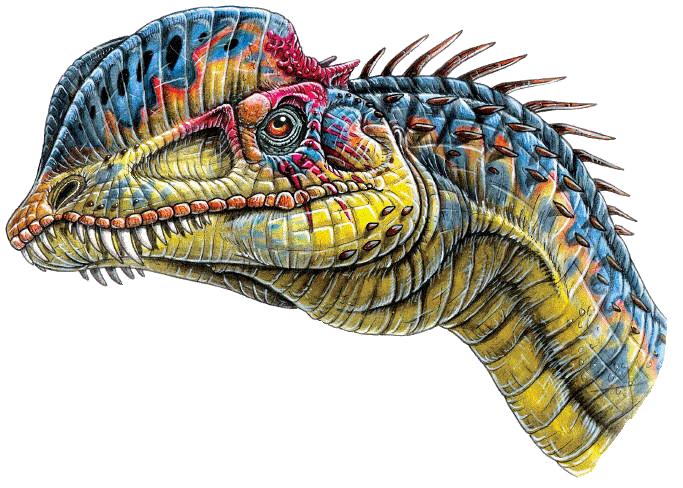|
Dilophosaurus wertherelli (Samuel P. Wells, 1954,
1984) |
 |
|
Name Means: |
"Double Crested Lizard" |
Length: |
Length:22 feet (7 m) |
|
Pronounced: |
die-Loaf-o-Saw-rus |
Weight: |
Weight:1,000 pounds (450 kilos) |
|
When it lived: |
Early Jurassic - 190 MYA |
|
|
|
Where found: |
Arizona, USA. |
|
|
|
Dilophosaurus was the largest meat-eater of the early Jurassic. It was made famous
by the movie Jurassic Park, but the movie did not present an accurate
picture of this dinosaur. The movie version (1) sported a retractable
frill around its neck, much like the famous Australian frilled lizard (2) was much smaller than the
real thing, had forward facing eyes to give it stereo vision
and (4) spat poison, aimed at eyes of its prey, to blind and paralyze
it. None of these characterized the real Dilophosaurus
But he was a very powerful animal that stood about eight feet
high. He weighed as much as a small horse had had long, strong
hind legs; forelimbs with hand that were flexible, with an opposable
thumb, so he could grasp a prey. His hind legs, his feet, were
armed with very powerful claws and were probably used as weapons as
well as for locomotion. He bipedal and probably a very rapid runner.
He had long and slender, rear-curving teeth in long jaws.
Dilophosaurus was carnivore, but had loosely attached jaws which would
have made killing animals with its teeth difficult. It must have
killed with its clawed arms and legs then used his teeth to pluck meat
from the carcass. In any event, he was the most capable killing
machine of his time so he certainly didn't to use poison.
The first fossil Dilophosaurus skeletons came from the Navajo
Indian Reservation, just west of Tuba City, Arizona. were found in
Arizona, USA, in the 1940's. A local Navajo guided Bill Rush, Ed
Kott and Samuel P. Welles of the University of California at Berkeley
to them. Wells said, "There were three dinosaurs in a triangle
about twenty feet apart and one was almost worthless having been
completely eroded. The second was a good skeleton showing everything
except the front part of the skull." "The third gave us the
front part of the skull and much of the front part of the skeleton.
These we collected in a ten day rush job, loaded them into the car,
and brought them back to Berkeley." Since three specimens were
found together, Dilophosaurus may have roved in packs.
The fossils of Dilophosaurus were found near large
footprints of carnivorous dinosaurs and they may belong to Dilophosaurus.
The original description was published in 1954 by Welles. At that time, it was
thought to be another genus of theropod (Megalosaurus). In
1970, it was recognized to be distinct and given its own generic name Dilophosaurus (meaning "two-crested lizard"). Welles later
redescribed the entire taxon in 1984 in a much more complete paper. Dilophosaurus may be a primitive member of the clade containing
both ceratosaurian and tetanuran theropods. Alternatively, some
paleontologists classify this genus as a large coelophysoid.
There is another species of Dilophosaurus (D.
sinensis) which may or may not belong to this genus. It is
possibly closer to the bizarre Antarctic theropod Cryolophosaurus,
based on fact that the anterior end of the jugal does not participate
in the internal antorbital fenestra and that the maxillary tooth row
is completely in front of the orbit and ends anterior to the vertical
strut of the lacrimal. This species was recovered from the Yunnan
Province of China in 1987 with the prosauropod Yunnanosaurus, and later described
and named in 1993 by Shaojin Hu. |
|
|
|
|
|
|
|
|
Edugraphics.Net | Feenixx Publishing |
|
|
|